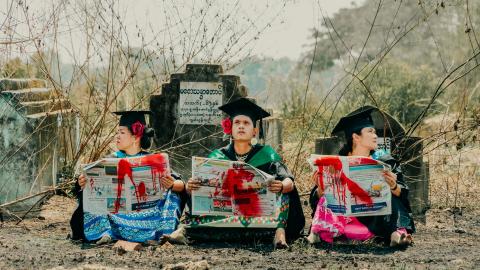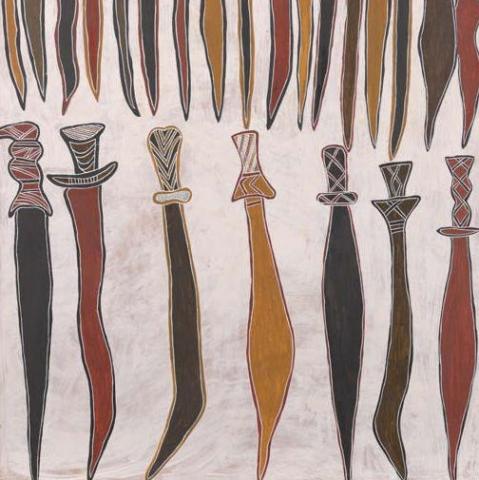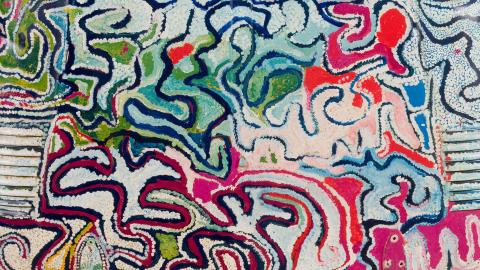Djirrit: A Macassan sail dhawu
By Diane Moon
Artlines | 1-2022 | March 2022
From the 1700s — perhaps even earlier — the Yolngu people of north-eastern Arnhem Land met and traded with the Macassan people of the Indonesian Archipelago. The APT10 Yolngu/Macassan Project explores how Yolngu travel, culture and art were influenced by the adoption of Macassan tools and boat designs, writes Diane Moon, who shares artist Gunybi Ganambarr’s story of how these ancient skills had a surprising modern application.
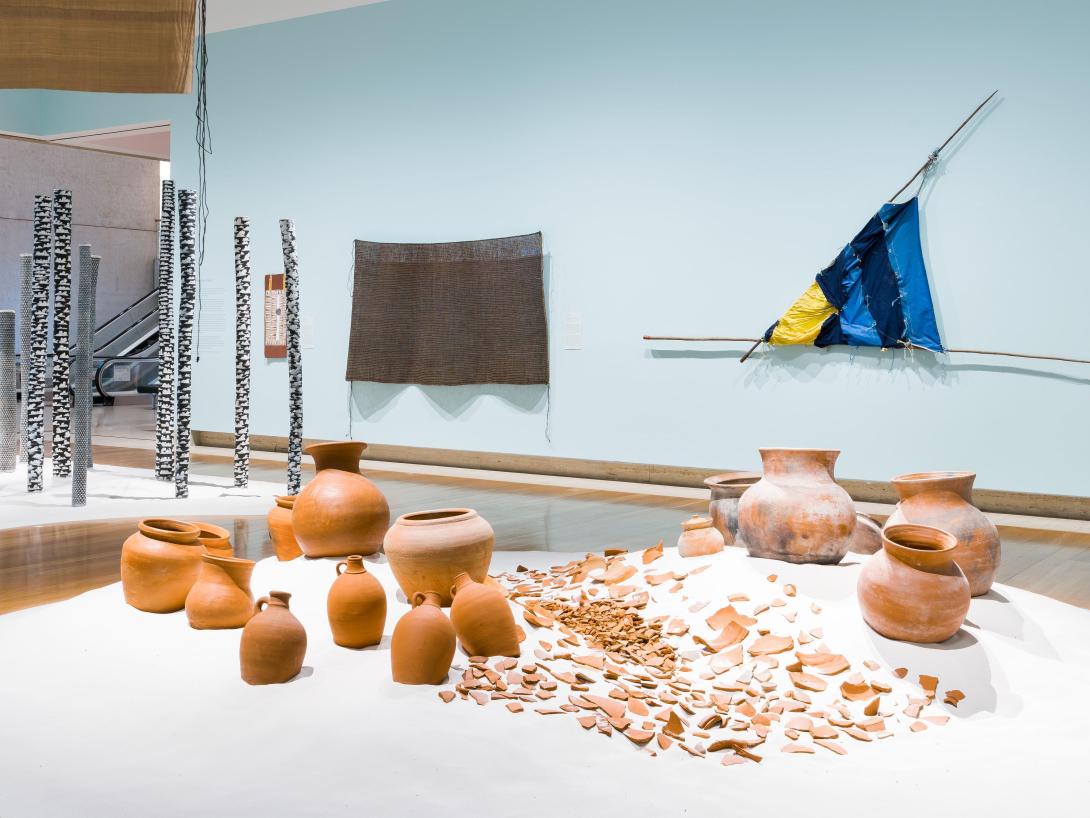
Installation view of the APT10 Yolngu/Macassan Project, Gallery 4, QAG (full caption at end) / Photograph: Natasha Harth
During the years of Macassan fishing/trading visits to north-eastern Arnhem Land, a woven pandanus sail design evolved for use with the lipalipa (dugout canoe) introduced by Macassan visitors. Yolngu learnt to carve the shallow craft from a single log with the metal tools Macassans brought with them, enabling navigation on the open seas for the first time, expanding marine hunting opportunities and communication between remote Yolngu families.
In early December 2020, artist Gunybi Ganambarr, along with his son Daniel, his djuŋgaya (spiritual manager) Yinimala Gumana and clansmen Mangila Munuŋgurr and Buluŋgitj Marawili, set off from their homeland at Gangan to go turtle-hunting. Their aluminium dinghy’s battery failed near Isle Woodah (also known as Woodah Island). They had fresh water, oysters, fire and shelter for the night, and in the morning, fashioned a Macassan-style sail from the materials at hand. Once tide and wind were favourable, they confidently set sail for home. Ganambarr’s own dhawu (story) — his account of the event — follows:
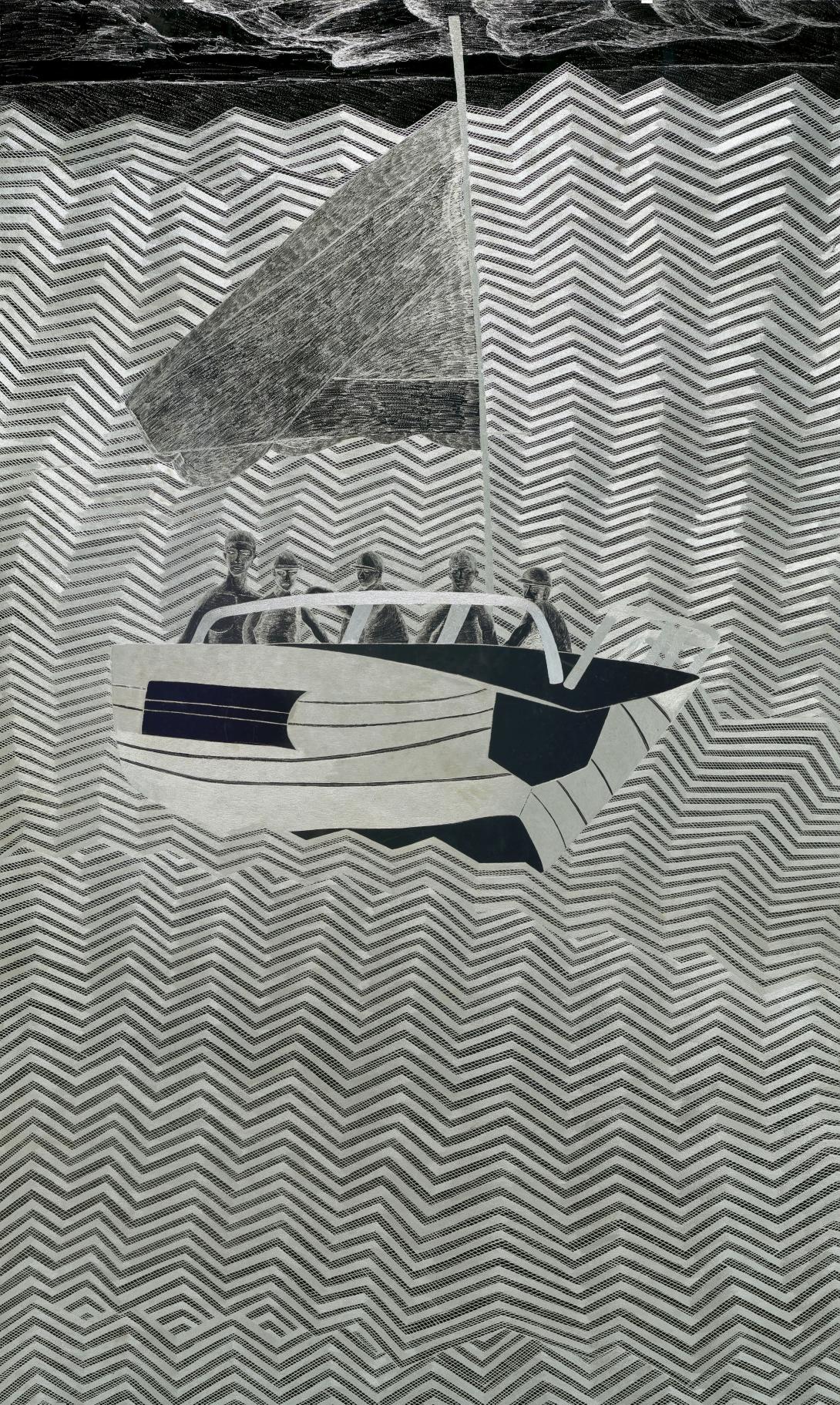
‘Djirrit’ is the name we call this sail with the diagonal mast. It was the late Dry season — the start of the Wet before the first rains start — this is the right time to hunt turtle and when the maypal (shellfish) and mekawu (rock oysters) are at their best. We intended to get mulkurrmi — using an axe to chop large sections of oysters off the rocks to bring home. We drove the boat down to Garrapara, where we launched and went straight out to Gunyuru (Round Hat Island). We cruised around for a while but didn't find any miyapunu (turtle). So, we went straight out to Woodah Island and immediately got two big dhalwa pu (green turtle). It’s a crazy thing, but by this time I was starving for ŋarali (cigarettes) and only had rolling tobacco and no papers. I hadn't brought my luŋiny (Macassan pipe). I took us into shore at Woodah Isle where I saw a luŋiny tree, so I could cut myself a pipe. We landed and I cut a pipe, hollowed out the stem, added a bullet shell as the bowl and had a smoke. When we went back to the boat and hopped in to take off again, we found the battery was flat. We couldn't start the boat! I tried pushing the starter repeatedly but there was no spark.
By this time, it was late afternoon. We had no firewood, so I went up the hill and got some, as well as some wu uku (driftwood) from the beach. We had three jerry cans of water and we had all the oysters we could eat. We had no light other than the moon and the fire, but we were joking and laughing and relaxed because we knew we could sail in the morning using the djambatj (turtle harpoons). I had already noticed the boat canopy and the ropes and knew that we could do it.
In the morning, Yinimala and I got the guys together and explained what we needed to do. We took copper wire off the spears to thread the work shirt and the canopy together and attach it to the harpoons, which we had tied together. When I woke that morning, I saw the waŋupini (thunderhead cloud) on the horizon and I said to Yinimala, ‘Look — that’s the wind waiting for us!’ (The same wind filled the sails of the Macassans on their early journeys.)
We were waiting a long time for the tide to come in, so we used wood to roll the boat out to meet the water. Then we let one of the turtles overboard with a rope attached and she towed us out into the deep water. As we reached the edge of the reef, I cut the rope to let her go, and the wind caught us.
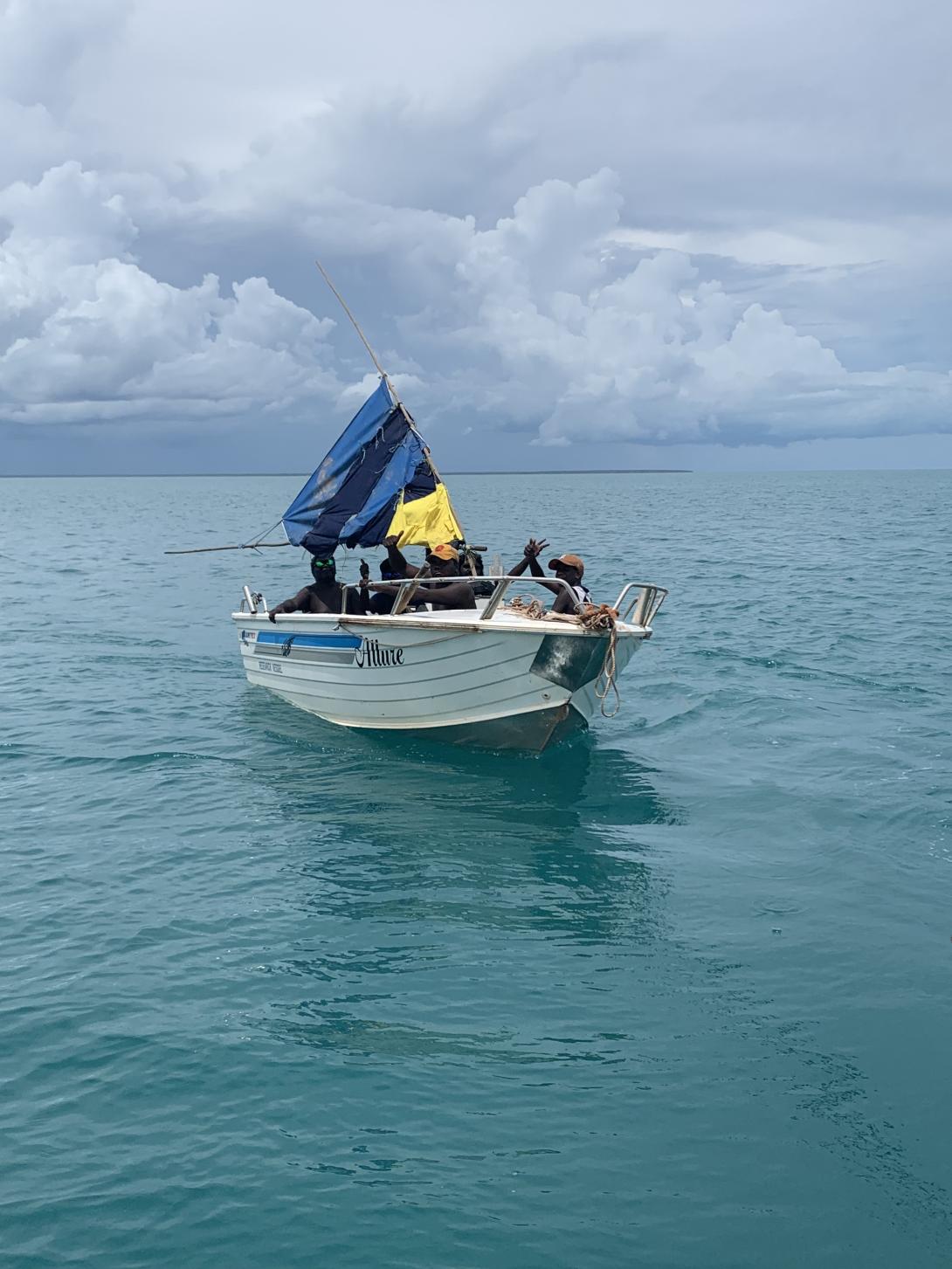
Gunybi Ganambarr and his crew with makeshift sail after engine failure as photographed by rescuing Water Police officers from Gapuwiyak, December 2020 / Image courtesy: Northern Territory Police Force
When they were well underway, the sailors were intercepted by a police boat from Gapuwiyak, west of Yirrkala, which had been launched to search for the men when their families had reported them missing. On their return to Yirrkala, the makeshift Macassan sail was purchased by the Buku-Larrŋgay Mulka Centre in Yirrkala for inclusion in the Yolngu/Macassan Project exhibit at APT10. A photograph of the dinghy and crew, taken by the police on a mobile phone, was posted to the Northern Territory Police Instagram account. Some months later, Ganambarr created Djirrit 2021, a large rendition of the photo, finely etched into black Alupanel, which is on display at APT10.
The Yolngu/Macassan Project, part of APT10, is supported by the Australian Government through the Office for the Arts.
Full caption (image at top): Installation view of the APT10 Yolngu/Macassan Project, Gallery 4, QAG / Photograph: Natasha Harth
Featuring: Nawarupu Wunungmurra / Dhalwangu/Narrkala people / Australia 1952–2018 / Mungurru (Ocean water) Dhalwangu Clan memorial poles 2008 / Wood with natural pigments / Five works: Installed dimensions variable / Purchased 2008. Queensland Art Gallery Foundation; Wangupini larrakitj 2016 / Earth pigments on stringybark (Eucalyptus tetradonta) / Nine works: Installed dimensions variable; Wangupini larrakitj 2017 / Earth pigments on stringybark (Eucalyptus tetradonta) / Six works: Installed dimensions variable / Gift of William JS Boyle, Frances Gerard, Aaron Gwinnett, Klein Family Foundation, Lipman Karas, Jane McGregor, Pam McKee, Diana McLaurin, John Phillips, Judith Rischbieth, James Sampson and Dr Joe Verco AM through the Art Gallery of South Australia Foundation Collectors Club 2017 and Acquisition through Tarnanthi: Festival of Contemporary Aboriginal and Torres Strait Islander Art, supported by BHP 2017 / Collection: Art Gallery of South Australia, Adelaide; Wangupini 2016 / Wood with natural pigments / Two works: 209cm; 247cm; Wangupini 2018 / Wood with natural pigments / Six works: Installed dimensions variable; and; Wangupini (Nawurapu larrakitj clouds) 2018 / Wood with natural pigments / 238 x 13cm (diam.) / Courtesy: Buku-Larrnggay Mulka Centre, Yirrkala / All works © Nawarupu Wunungmurra; Margaret Rarru / Liyagawumirr people / Australia b.1940 / Dhomala (Macassan canoe sail) 2019–20 / Woven pandanus (pandanus spiralis), hand-rolled kurrajong (brachychiton populneus) bark string / 150 x 281cm / Commissioned 2019 with funds from the QAGOMA Foundation / © Margaret Bilinydjan Rarru/Copyright Agency; Gunybi Ganambarr / Ngaymil people / Australia b.1973 / Macassan sail 2020 / Stitched boat canopy and work shirt, wooden turtle-hunting harpoons / 233 x 400cm / Courtesy: Buku-Larrŋgay Mulka Centre / Photograph: Merinda Campbell / © Gunybi Ganambarr; Various artists / Indonesia/Australia / Collection of Macassan ceramic bottles, water and cooking pots made in Indonesia and painted in Yirrkala, Arnhem Land 2021 (installation view) / Ceramic with earth pigments and polyvinyl acetate / Installed dimensions variable / Courtesy: The artists and Buku-Larrnggay Mulka Centre, Yirrkala
Explore related works

Djirrit 2021
- GANAMBARR, Gunybi - Creator

Macassan sail 2020
- GANAMBARR, Gunybi - Creator
Digital story context and navigation
APT10Explore the story
About this page

